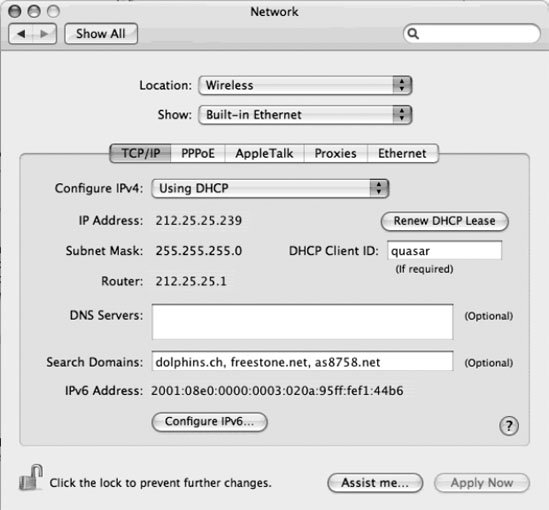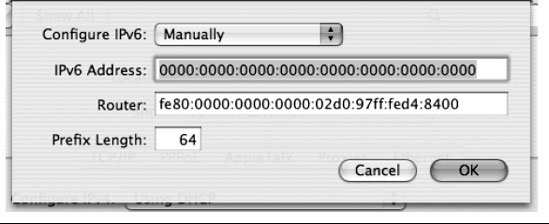Section 12.4. Macintosh
12.4. MacintoshMac OS X is the latest version of the Mac OS, the operating system software for Macintosh computers. Mac OS X was first commercially released in 2001. It consists of two main parts: Darwin, an open source Unix-like environment based on the Berkley Software Distribution (BSD) and the Mach microkernel, adapted and further developed by Apple Computer with involvement from independent developers, and a proprietary GUI named Aqua developed by Apple. Mac OS X versions are named after large felines. Currently, there are five versions released (the newest release, called Leopard, is announced for the end of 2006 or early 2007):
Network services are based on the standard TCP/IP implementation of FreeBSD. The IPv6 and IPsec implementation is based on the basic principles of the KAME project (http://www.kame.net), briefly described earlier in the section on BSD. OS X currently comes with the following services with IPv6 support:
Basically, all command-line tools from FreeBSD, such as traceroute6, ping6, and netstat may be used in Mac OS X without any problems. See the manpages for all parameters. The GUI tool for network configuration supports IPv6 configuration since version 10.3. Figure 12-2 shows the network configuration wizard in 10.4. Figure 12-2. Network configuration in MAC OS X This screenshot shows the part of the network dialog where you find the IPv4 configuration optionsin this case, of the built-in wireless interface. At the bottom of the screenshot, the IPv6 address and the Configure IPv6 . . . button used to access the IPv6 configuration are displayed. What you see in Figure 12-3 is displayed when you press the Configure IPv6 button. In this case, it shows the configuration options in manual mode. Figure 12-3. IPv6 manual configuration in MAC OS X In the first option, you can choose between Stateless autoconfiguration and manual configuration. If you choose Stateless autoconfiguration, the interface will configure itself following the rules for Stateless autoconfiguration. In this case, no options can be configured (they will be grayed out). If you choose static configuration, the mode called Manually, you must enter your own IPv6 address, your Default Router's link-local IPv6 address, and the prefix length. If OS X's IPv6 stack recognizes IPv6 Router Advertisements while booting, Stateless autoconfiguration is activated by default. Here is a sample shell script configuration for use with a Tunnel Broker. You need an account on a public Tunnel Broker and may change the following script with your personal parameters. LOCAL4 is your public (static) IPv4 address; REMOTE4 is the tunnel endpoint given by the Tunnel Broker service. LOCAL6 is your router's IPv6 address, which must be within your IPv6 subnet. REMOTE6 is the IPv6 address of the tunnel endpoint. For more detailed information on tunneling and Tunnel Broker concepts, refer to Chapter 10. #!/bin/sh # # configuration in case of using swiss tunnelbroker.as8758.net LOCAL4=213.160.42.62 REMOTE4=212.25.25.23 LOCAL6=2001:08e0:abcd::2ce/126 REMOTE6=2001:08e0:abcd::2cd/126 ifconfig gif0 create ifconfig gif0 tunnel ${LOCAL4} ${REMOTE4} ifconfig gif0 inet6 alias ${LOCAL6} route add -inet6 default -interface gif0 |